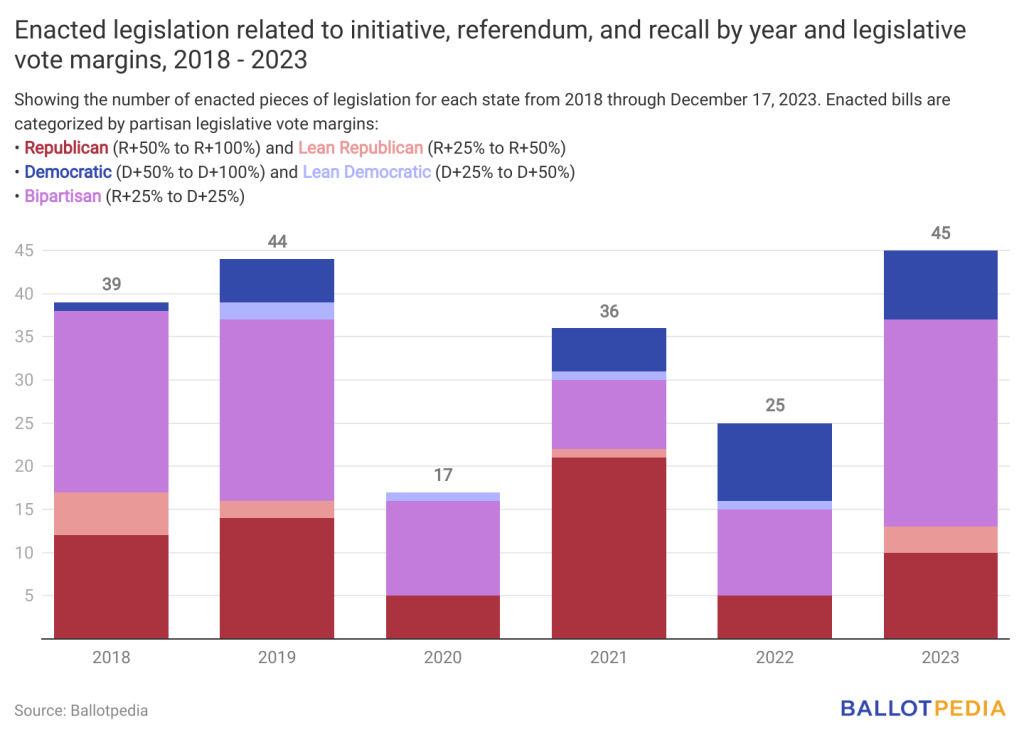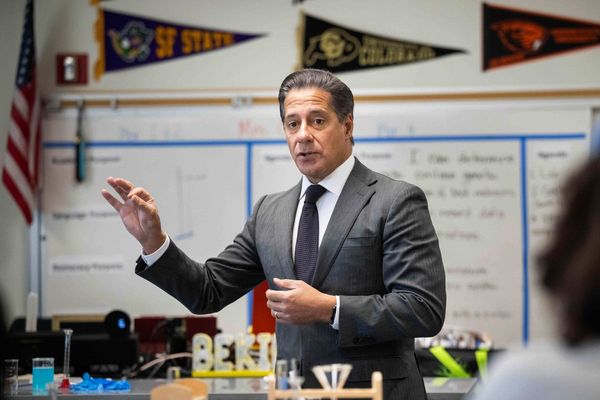Legislatures enacted more pieces of legislation related to direct democracy—ballot initiatives, referendums, and recall petitions—in 2023 than the previous five years. In 2023, 45 bills and resolutions were enacted, which exceeds the annual average of 32 for this period. The previous largest number of bills enacted was 44 in 2019.
While there was an increase in the number of bills enacted, there was a decrease in bills designed to make the initiative process more difficult. In 2023, five such pieces of legislation were enacted, which is less than the average of seven.
There was an increase in bills designed to make the initiative process less difficult. In 2023, four such pieces of legislation were enacted, which is higher than the average of two. In Maine and South Dakota, two of this year’s changes to make the initiative process less difficult were in response to court rulings.
You can learn more about our ballot measure legislation coverage here:
- Changes in 2023 to laws governing ballot measures
- Difficulty analysis of changes to laws governing ballot measures
- Analysis of 2018-2023 changes to laws governing ballot measures
Summary of 2023
In 2023, there was an increase in the number of proposed and enacted bills and resolutions related to ballot initiatives, referendums, and recall petitions.
Proposed Legislation: In 2023, 385 bills and resolutions related to ballot initiatives, referendums, and recall petitions were introduced nationwide. This number marks an increase from the annual average of 286 proposals. Lawmakers approved 45 (11.7%) of the 385 pieces of legislation introduced in 2023.
- 234 (60.8%) were introduced in the 26 states with a statewide citizen-initiated ballot measure process.
- 195 (50.7%) were introduced in the 22 states with Republican trifectas, 139 (36.1%) were introduced in the 17 states with Democratic trifectas, and 51 (13.2%) were introduced in the 11 states with divided governments.
- Missouri, which has an initiative and referendum process, saw the most introduced bills at 42; however, none of these bills were passed and enacted.
Enacted Legislation: 45 bills and resolutions were enacted in 2023. The state that enacted the most changes in 2023 was California, with seven pieces of legislation. Maine had the second most with six, and Arkansas and Montana each had five.

Partisanship: 24 of the 45 enacted bills (53.3%) received bipartisan backing, 13 (28.9%) were passed with Republican majorities, and eight (17.8%) with Democratic majorities. In 2023, Republicans had trifectas in 13 (50.0%) of the 26 states that provide for statewide initiative and referendum. Democrats had trifectas in 10 (38.5%), and three (11.5%) states had divided governments.
- The five bills to make the ballot initiative process more difficult were passed with Republican majorities.
- Of the four bills passed to make the process less difficult, three received bipartisan support, and one was passed with a Democratic majority.
- In 2023, John Matsusaka, Director of the Initiative & Referendum Institute, published an analysis of state constitutional amendments that increase the cost of proposing or approving ballot initiatives. He found that from 1960 to 2022, “proposals to restrict initiative and referendum rights were common throughout the period.” His data indicates that there was a shift around 2000. Before 2000, about 50% of the amendments originated in Republican-controlled legislatures, while about 25% originated in Democratic-controlled legislatures and 25% originated in divided legislatures. After 2000, Republicans continued proposing constitutional amendments but the numbers fell for Democratic-controlled legislatures and divided legislatures.
Constitutional Amendments: Of the legislation enacted in 2023, seven were constitutional amendments needing voter approval. Three appeared on ballots in 2023, while four are scheduled for 2024. Seven is the highest number of constitutional amendments referred to the ballot during a single year since at least 2018. The annual average is three.
- In 2023, voters rejected Ohio Issue 1, which would have required a 60% vote to approve constitutional amendments, and Maine Question 7, which would have removed language from the state constitution requiring that an initiative petition signature gatherer must be a resident and registered voter of Maine. Question 7 would have repealed language that was ineffective due to a federal court ruling. Voters approved Maine Question 5, which changed the judicial review period for initiatives from within 100 days of a petition being filed to within 100 business days from the deadline for filing a petition.
- In 2024, voters will decide on Arizona SCR 1015, which would establish a signature distribution requirement for citizen initiatives, and North Dakota Measure 2, which would make several changes, including enacting a single-subject requirement, increasing the signature requirement for initiated constitutional amendments, and requiring initiated amendments to be approved at two elections.
- Voters in California will also decide on two constitutional amendments in Nov. 2024. California ACA 1 would reduce the vote threshold from two-thirds to 55% for local special tax and bond ballot measures that fund public infrastructure, affordable housing, or supportive housing for persons at risk of chronic homelessness. As of 2023, a two-thirds (66.67%) vote of the electorate was required to approve a local special tax ballot measure or general obligation bond, except for school district bond measures. ACA 13 would require that initiatives to adopt or increase supermajority requirements for ballot measures must pass by the same supermajority vote requirement being proposed. ACA 13 was also designed to allow local governments to refer non-binding questions to the ballot.
Readability: Both New York and North Dakota enacted legislation designed to enhance the readability of ballot measure language.
- In New York, the legislature passed SB 1381, which requires that state ballot measure questions be written in plain language and at no higher than an eighth-grade reading level.
- In North Dakota, the legislature passed SB 2163, which requires summaries of ballot measures to be written in “plain, clear, understandable language using words with common, everyday meaning.”
- Ballotpedia publishes an annual report on the readability of ballot measure language. In 2023, the average grade-level score was 19 years of education, and the average for 2017 through 2023 was 18 years of education, according to the Flesch-Kincaid Grade Level (FKGL) formula.
Advisory votes: In 2023, Washington and Wisconsin passed legislation eliminating certain non-binding advisory votes.
- Washington enacted SB 5082, which repealed mandatory advisory votes on tax increases, a practice initially approved by voters in 2007 through Initiative 960.
- In Wisconsin, an omnibus bill concerning local shared revenue and taxes was passed, including a provision that prohibits local governments from placing non-binding advisory questions on ballots, except for specific fiscal or utility issues.
In 2024, Ballotpedia will provide comprehensive coverage of ballot measure legislation here. Typically, more pieces of legislation are proposed and enacted during odd-numbered years, like 2023, than even-numbered years, like 2024. This is likely because many state legislative sessions are two years long, starting in the odd-numbered year, and more bills are introduced at the start of the two-year session.







